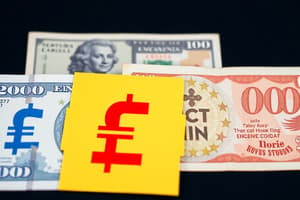Podcast
Questions and Answers
What is the difference between nominal and real interest rates?
What is the difference between nominal and real interest rates?
The nominal interest rate is the rate you pay on a loan. The real interest rate is the nominal interest rate adjusted for inflation.
Why does the credit demand curve slope downward?
Why does the credit demand curve slope downward?
A higher real interest rate reduces a borrowing firm's profit and hence its willingness to borrow.
What can cause a shift in the credit demand curve?
What can cause a shift in the credit demand curve?
Changes in government policy, changes in perceived business opportunities for firms, and changes in household preferences or expectations.
Why does the credit supply curve slope upward?
Why does the credit supply curve slope upward?
What can cause a shift in the credit supply curve?
What can cause a shift in the credit supply curve?
What is the formula to find the real rate of interest?
What is the formula to find the real rate of interest?
Who benefits if the economy experiences an unexpectedly low rate of inflation?
Who benefits if the economy experiences an unexpectedly low rate of inflation?
Why do the inflation rate and the nominal interest rate tend to move together over the long run?
Why do the inflation rate and the nominal interest rate tend to move together over the long run?
If pi denotes the rate of inflation and i denotes the nominal rate of interest, the amount a borrower repays in a year on a one-dollar loan is _____ and the inflation-adjusted purchasing power of the originally borrowed dollar is _____
If pi denotes the rate of inflation and i denotes the nominal rate of interest, the amount a borrower repays in a year on a one-dollar loan is _____ and the inflation-adjusted purchasing power of the originally borrowed dollar is _____
What is subtracted from the amount a borrower repays in a year on a one-dollar loan?
What is subtracted from the amount a borrower repays in a year on a one-dollar loan?
What can produce a movement along the credit demand curve?
What can produce a movement along the credit demand curve?
What categories balance with assets?
What categories balance with assets?
What categories balance with stockholders?
What categories balance with stockholders?
What is the process of channeling funds from suppliers of financial capital to users called?
What is the process of channeling funds from suppliers of financial capital to users called?
What are the two basic types of financial capital?
What are the two basic types of financial capital?
Flashcards are hidden until you start studying
Study Notes
Interest Rates
- Nominal interest rates represent the stated rate on loans, while real interest rates adjust the nominal rate for inflation.
- Real interest rate can be calculated using the formula: Real interest rate = Nominal interest rate - Inflation rate.
Credit Demand and Supply
-
The credit demand curve slopes downward due to higher real interest rates reducing profit for borrowing firms, thereby decreasing their willingness to borrow.
-
A shift in the credit demand curve can result from changes in government policy, business opportunity perceptions, or household expectations.
-
The credit supply curve slopes upward because elevated real interest rates discourage immediate consumption and encourage saving.
-
Shifts in the credit supply curve can emerge from perceptions of economic uncertainty, an aging population's retirement readiness, and firms’ desires to self-fund activities.
Inflation and Its Effects
- Unexpectedly low inflation rates benefit creditors, who are owed money, as the purchasing power of repayments increases.
- Inflation rates and nominal interest rates tend to move together in the long run, reflecting stable credit market conditions and a relatively stable real interest rate.
Borrowing Dynamics
- When a borrower takes a one-dollar loan, the total repayment amount in a year is represented by (1 + i), where i is the nominal interest rate.
- The inflation-adjusted purchasing power of the original dollar loan is represented by (1 + π), where π is the inflation rate.
Financial Intermediation
- The process of channeling funds from suppliers to users of financial capital is termed financial intermediation.
- Financial capital can be classified into two basic types: credit and equity.
Balance Sheet Components
- Key asset categories balancing with liabilities include long-term investments, reserves, and cash equivalents.
- Key liabilities and stockholder components include long-term debt, demand deposits, stockholder equity, and short-term borrowing.
Studying That Suits You
Use AI to generate personalized quizzes and flashcards to suit your learning preferences.




